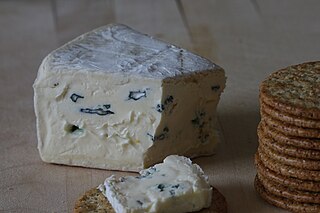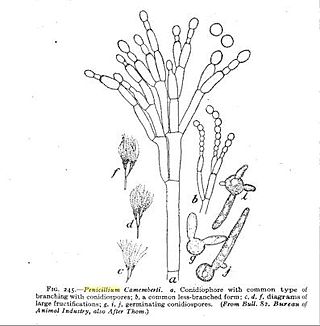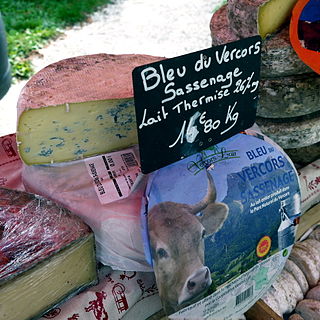
Penicillium is a genus of ascomycetous fungi that is part of the mycobiome of many species and is of major importance in the natural environment, in food spoilage, and in food and drug production.

Roquefort is a sheep milk cheese from Southern France, and is one of the world's best known blue cheeses. Though similar cheeses are produced elsewhere, EU law dictates that only those cheeses aged in the natural Combalou caves of Roquefort-sur-Soulzon may bear the name Roquefort, as it is a recognised geographical indication, or has a protected designation of origin.

Blue cheese is semi-soft cheese with a sharp, salty flavor. It is made with cultures of the edible mold Penicillium, giving it spots or veins throughout the cheese in shades of blue or green. It carries a distinct smell, either from the mold or from various specially cultivated bacteria such as Brevibacterium linens, which also causes foot odor and other human body odors.

Cambozola is a cow's milk cheese that is a combination in style of a French soft-ripened triple cream cheese and Italian Gorgonzola.

Bleu d'Auvergne is a French blue cheese, named for its place of origin in the Auvergne region of south-central France. It is made from cow's milk, and is one of the cheeses granted the Appellation d'origine contrôlée from the French government.

Penicillium roqueforti is a common saprotrophic fungus in the genus Penicillium. Widespread in nature, it can be isolated from soil, decaying organic matter, and plants.

Penicillium camemberti is a species of fungus in the genus Penicillium. It is used in the production of Camembert, Brie, Langres, Coulommiers, and Cambozola cheeses, on which colonies of P. camemberti form a hard, white crust. It is responsible for giving these cheeses their distinctive flavors. An allergy to the antibiotic penicillin does not necessarily imply an allergy to cheeses made using P. camemberti.

Bleu de Bresse is a blue cheese that was first made in the Bresse area of France following World War II. Made from whole milk, it has a firm, edible coating which is characteristically white in color and has an aroma of mushrooms. Its creamy interior, similar in texture to Brie, contains patches of blue mold. It is shaped into cylindrical rounds weighing from 125 to 500 grams.

Cyclopiazonic acid (α-CPA), a mycotoxin and a fungal neurotoxin, is made by the molds Aspergillus and Penicillium. It is an indole-tetramic acid that serves as a toxin due to its ability to inhibit calcium-dependent ATPases found in the endoplasmic and sarcoplasmic reticulum. This inhibition disrupts the muscle contraction-relaxation cycle and the calcium gradient that is maintained for proper cellular activity in cells.
Penicillium crustosum is a blue-green or blue-grey mold that can cause food spoilage, particularly of protein-rich foods such as meats and cheeses. It is identified by its complex biseriate conidiophores on which phialides produce asexual spores. It can grow at fairly low temperatures, and in low water activity environments.

Bleu du Vercors-Sassenage is a mild pasteurized natural rind cow's milk blue cheese originally produced by monks in the Rhône-Alpes region of France in the 14th century. Now made in the Dauphiné area, the cheese has been a protected Appellation d'Origine Contrôlée since 1998. As a requirement, the cheese has to be composed of milk from Montbéliard, Abondance or Villard cows. The cheese is unpressed and uncooked and contains the mold Penicillium roqueforti. In Larousse's Grand Dictionnaire Universel of the 19th century, King Francis I is described as being quite fond of the cheese.
Lanark Blue is a sheep milk cheese produced in Lanarkshire, Scotland.
The enzyme aristolochene synthase catalyzes the chemical reaction
The enzyme germacrene-A synthase catalyzes the chemical reaction

Roquefortine C is a mycotoxin that belongs to a class of naturally occurring 2,5-diketopiperazines produced by various fungi, particularly species from the genus Penicillium. It was first isolated from a strain of Penicillium roqueforti, a species commercially used as a source of proteolytic and lipolytic enzymes during maturation of the blue-veined cheeses, Roquefort, Danish Blue, Stilton and Gorgonzola.
Deuterolysin is an enzyme. This enzyme catalyses the following chemical reaction

Andrastin A is a farnesyltransferase inhibitor isolate of Penicillium species including Penicillium albocoremium and Penicillium roqueforti. It has been produced bio-synthetically by porting the relevant gene sequence into Aspergillus oryzae.
Penicillium carneum is a fungus species of the genus of Penicillium.Penicillium roqueforti var. carneum was reclassified to Penicillium carneum.P. carneum was isolated from spoiled meat products, silage, rye bread, water, beer, cheese, mouldy barkers yeast and cork. P. carneum produces patulin, penicillic acid, penitrem A, mycophenolic acid roquefortines.
Penicillium psychrosexualis is a filamentous fungus in the genus Penicillium. Described as new to science in 2010, the species was found growing on refrigerated moldy apples in the Netherlands. It is closely related to the blue cheese fungus P. roqueforti.

Penicillin Roquefort Toxin is a mycotoxin produced by the fungi Penicillium roqueforti. In 1973, PR toxin was first partially characterized by isolating moldy corn on which the fungi had grown. Although its lethal dose was determined shortly after the isolation of the chemical, details of its toxic effects, were not fully clarified until 1982 in a study with mice, rats, anesthetized cats and preparations of isolated rat auricles.













